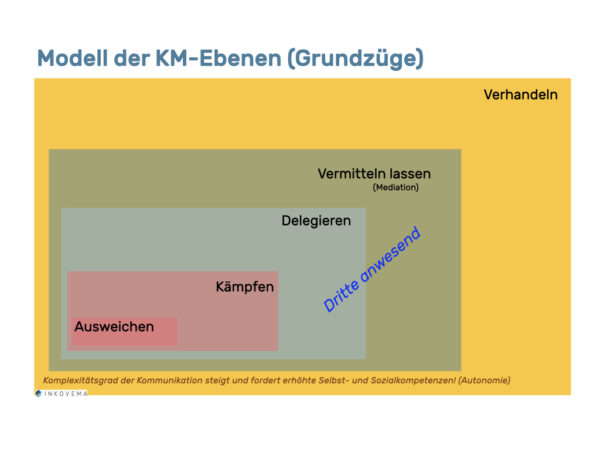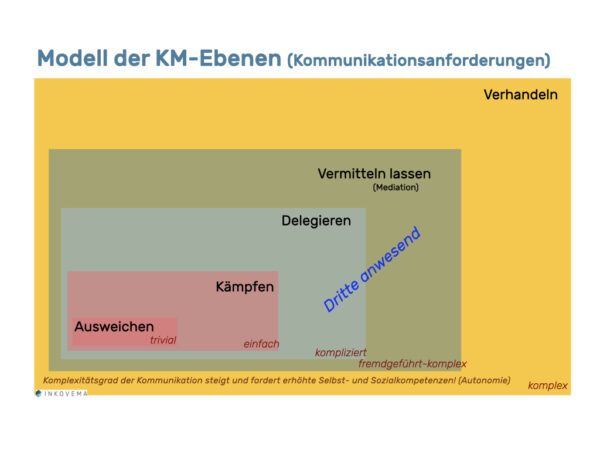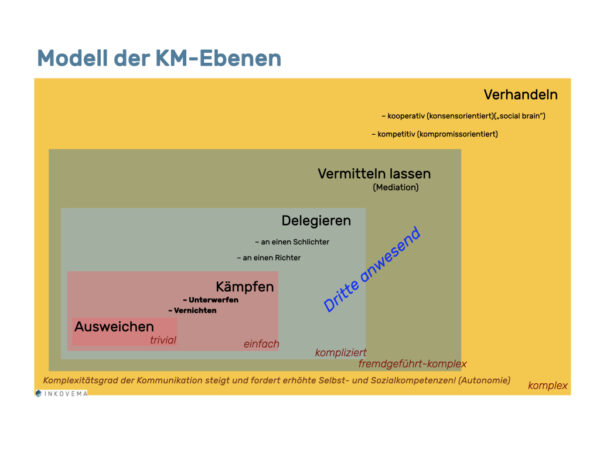Model of conflict management levels
25 Basics of mediation (9)
The following model of conflict management levels is based on its origins G. Black and illustrates a development process that individuals as well as groups and societies go through - or not. It declares five distinct levels that are subject to their own rules and requirements and that each have specific requirements for the degree of development of social communication and its accompanying phenomena.
I will also Driving ideas of the individual levels that challenge and promote transitions.
The distinction between the different levels in dealing with conflicts is crucial. The levels of the Evasion and Fighting from those in which third parties become active in the conflict. These third parties are usually either in the Delegation or Mediation and they, in turn, differ from the Levels of negotiationon which the parties to the conflict (again) act without the help of third parties. Graphically, it looks something like this:
Starting points of the KM levels model
The fact that these are levels is intended to emphasise that the previous level is always present and potentially still available. The model does not evaluate the individual levels. There is no level or processing method that is per se better or worse, morally preferable or more reprehensible than others. It is up to the parties involved to decide for themselves which method is best for them, given the contextual conditions (e.g. legal system).
The model indicates which options exist in principle and where one's own choice could be located. In this respect, it offers a Mental map for analysing and proceeding in conflict situations and can therefore encourage people to reflect on their own preferences and, if necessary, expand the options they have previously utilised.
The Initial perspective for modelling recognisable conflict management methods are the Requirements for the social communication of those involved. At the level of evasion, there is relatively little demand on the forms of social interaction. Or to put it simply: if one person evades, the other notices. No great effort is required to communicate clearly.
This does not always put an end to the conflict; on the contrary, it can be dealt with on a different level. For example, in times of war, the raising of the white flag may have ended the battle by "evading" it, but it was often the first time that negotiations between the warring parties were made possible or even wrested (What happens to the prisoners? And what happens now?). This example shows that it is relatively easy to oscillate between levels and methods.
While the social interaction form of evasion is relatively trivial, the demands on personal and social skills increase on the other levels, so that from this perspective only the levels of mediation and negotiation present themselves as complex levels of challenge.
Now the system-theoretical point of view From this perspective, all communication between people is complex because people are "complex systems" or "non-trivial machines" (Heinz von Foerster). In this respect there could be an inaccuracy if the model describes dodging or fighting as trivial or simple.
However, these are different issues. In the context of conflicts, fleeing, evading or fighting is not a particularly complex matter, but it can sometimes be problematic in practice. It is not possible for the person fleeing or fighting to predict what understanding the other person will develop from their flight or attack. This aspect of communication is complex. Acting as such is not.
The five levels of conflict management:
Evade – Fight – Delegate – Let mediate – Negotiate
Dodging and fighting
Fight and flight reactions, which are well reflected in our neurobiological structure and in our "hormonal stress axis" (Bauer), are our original Conflict reactions. Their presence ensures that we can escape effectively and thus survive if necessary. They not only help us in jungle-like Situations, when we come face to face with a dangerous animal, which has certainly become rare for most of us. But even in the Urban jungle There are one or two situations in which an immediate, rash evasion can be quite helpful. However, our hormonal stress axis is activated much more frequently in our everyday conflict situations with our superiors, life partners, business partners, etc..
We humans generally "favour" fleeing over fighting, whereby physical combat is meant here, not verbal combat, which is a form of competitive negotiation. Physical combat encompasses all forms of conflict resolution through physical contact with the will to destroy or subjugate. The other person is not accepted for who they are and is fought against. Such aggressive behaviour does not arise from a "fight for survival", but from a desire to create successful relationships (with third parties).
Delegate
If the conflict cannot be resolved by fighting, because only Pyrrhic victories (i.e. successes bought at too high a price) would be possible and any escape is blocked, a third party is needed to escape the common stalemate. Certain decision-making competences are delegated to this third party. In the most intensive form of delegation, this is a decisive third party who is informed about the parties to the conflict and their directedso that they do not ruin themselves. This third party is consequently called Judge.
If no judgement is made, but only recommendations are made, and if such proposed solutions can also be rejected, a Conciliator. Referee are - nomen est omen - also judges, who may, however, be selected independently by the parties involved.
Get mediated
An enormous step in the joint shaping of the (conflict) relationship is taken when the parties involved have a involve a third party, but withhold any decision-making authority in the matter and not instruct him to find a solution to the conflict, but to the to support the parties in finding such a solutionn. This third person is then called Mediator or, with even less authority to intervene, Moderator.
In the Mediation and also in conflict moderation, the aim is to conduct autonomous and constructive, i.e. solution-orientated, negotiations with the help of a third party. Mediators and moderators are available for this purpose. The parties involved realise that they ultimately have to resolve their conflict themselves and basically want to, but are obviously not yet able to - and install a third party to help them communicate non-violently and on an equal footing and not (again) fall into verbal opposition.
This is why the third person pays less attention to the superficial conflicts.againstThe third party encourages the participants to listen more to these 'background noises' instead of pouncing on the obvious, which often only contains superficial, initially recognisable information. The third party encourages the participants to listen more to these 'background noises' instead of focussing on the obvious, which often only contains superficial, initially identifiable information. As "common third party" the mediator or moderator focusses on the constructive elements and does not pursue destructive conflict management approaches.
(If you want to know more about the third party in the conflict, take a look at this article here).
Negotiate
The most comprehensive level of conflict management methods leads "back" to independence. The triangle is dissolved and the third party is dismissed. It is now important to act independently again, having grown in the conflict, and in this way to shape it constructively together. If the parties have "skipped" the delegation and mediation level, they often negotiate with a inner attitude of the oppositionso competitive. However, if they see themselves as equal negotiators with equal rights who want to organise their social relationship in a fair and non-violent manner, they negotiate co-operative. Competitive negotiations lead at best to Compromisesenable co-operative negotiations Consensus.
It is important to emphasise that the individual levels always exist and remain as potentials. It is a cognitive model that serves to categorise conflict communication and thereby help to expand one's own possibilities. In fact, all levels are important and the choice of which one to use can only be made in a specific conflict situation. It is helpful if one's own personality has matured to such an extent that all levels can be accessed in principle and there are no mental limitations. Mental limitations include (unconscious) prejudices ("He's like that, you can't talk to him, it doesn't help to talk to him"). only one on the face!") or ("I am not allowed to defend myself violently, even if the other one wants to hit me…I must flee or submit."). By their very nature, they are MUST concepts that limit and devalue the available options. Transactional analysis addresses them with the devaluation concept or matrix. It is also beneficial if one's own decision is made autonomously and in view of the good reasons for the otherness of the other person. This involves skills such as empathy, foresight and an okay-ok attitude.
Deepening: Delegating with law and learning with mediation
Nowadays, delegation often takes place in the name of and within the legal system. Since the state legal system is the authoritative system of delegation, it plays a decisive role in the model of conflict management levels.
Two important features of the legal system for general conflict management are of interest here. On the one hand the Power component of the law. The judge embodies the Monopoly on the use of force. This prevents unauthorised violence by those involved. An unparalleled achievement of civilisation. On the other hand, the legal system invites communication - coded in a right/wrong binary - i.e. to Verbal fights. Just as the delegation level ends the physical fights, mediation ends the physical fights thanks to its Ideas of equalisation and mediation the verbal battles.
Mediation and law - fundamental difference for the third party
If the path back to violence is blocked by the delegation system, it only goes in the other direction: the Third party "receives" other competences and ordersto help the parties involved, so that the offer of mediation differs fundamentally from the legal system. While the law endeavours to achieve physical peace, mediation strives to explore the possibilities of the parties in general with a view to the future. Whereas the law preserves (the status quo ante), activates the Mediation future-orientated. This activation is mainly caused by the so-called Transformation ideas worn.
This already indicates what will become even clearer later: The delegation or legal system offers a solution to the problem of violence, but not to the social conflict as such. The parties may use the judge's decision to end their social conflict, but this remains a side effect from the judge's point of view. The decisive factor for them is that the conflict does not escalate further into fighting and violence.





On the levels of avoidance and fighting: It is good to know that fight and flight reactions are well reflected in our neurobiological structure and in our "hormonal stress axis" (Bauer). I am currently experiencing the frequent activation of the "hormonal stress axis" in everyday conflict situations very often.
From a family point of view, I'm the "being like that" type.